Smart City Products and Their Materials Assessment Using the Pentagon Framework
Abstract
1. Introduction
State of the Art
2. Materials and Methods: The Pentagon Framework
- Smart: Uses technology for intelligent systems to optimize urban services and improve quality of life, such as expert risk assessment models and advanced control systems [30].
- Sensing: Involves sensors and data technologies for monitoring urban systems and supporting decision making, like using optical fiber sensors for railway monitoring [31].
- Sustainable: Focuses on environmental stewardship and integrating sustainability into urban planning, as highlighted by Tura and Ojanen [32].
- Social: Emphasizes social inclusion, quality of life, and equitable access with concepts like the ’societal smart city’ introduced by Alizadeh and Sharifi [33].
- Safe: Ensures safety in urban areas, integrating measures into healthcare, transport, and planning to enhance security [34].
2.1. Enhancing Urban Living with the Pentagon Framework: A Citizen-Centric Approach to Smart Cities
Introducing the Smart C3 Model
- Smart Citizen: An individual who utilizes technology to engage within a smart city, address local issues, and participate in decision making.
- Smart Community: A network that interacts through connected products, where community members adopt various management methods and a shared community philosophy with multi-network integration.
- Smart City: A framework that uses data and modern technologies to enhance services and improve the quality of life for residents now and in the future.
2.2. Product Development Framework for Smart Cities
- Product Ideation: This stage emphasizes generating ideas aligned with the Penta-S framework to meet smart city stakeholders’ needs. It involves identifying innovative concepts incorporating smart, sustainable, sensing, social, and safe elements using tools like megatrends analysis, empathy maps, and ethnographic studies [28]. Customer needs are analyzed through the Jobs-To-Be-Done (JTBD) framework and a needs–satisfiers matrix. Promising ideas are selected for development using Pugh charts for comparison and storyboarding to illustrate functionalities [40].
- Conceptual Design and Specification: This stage defines the product concept and target specifications by aligning customer needs with technical requirements. It includes functional decomposition to outline key functionalities, documentation of technical specifications, and concept generation to propose and evaluate multiple ideas. Tools like Quality Function Deployment (QFD) and morphological matrices assist in selecting the best options [28].
- Detailed and Engineering Design: This phase transforms the product concept into a detailed design emphasizing smart, sensing, social, sustainable, and safe solutions. Key activities include creating detailed models (e.g., CAD and circuit designs), refining layouts, and developing technical drawings. Simulations and testing ensure the design meets specifications and standards, including failure analysis and environmental impact assessments [28].
- Prototyping: This stage involves developing and testing prototypes to validate design performance and sustainability. Functional prototypes are created using 3D models and microcontrollers, then integrated and tested under lab conditions. Techniques like FMEA (Failure Mode and Effects Analysis) and LCA (Life Cycle Assessment) ensure functionality and enable refinement [28].
2.3. Products’ Life Cycle Phases and Influential Factors
- Supply Chain: This phase involves responsibly sourcing raw materials and components and prioritizing sustainable and ethical practices. Efficient logistics and transportation methods are also emphasized to minimize environmental impact.
- Manufacturing: In this phase, the focus is on producing Penta-S products using energy-efficient processes, minimizing waste, and adopting environmentally friendly materials. Manufacturing should also incorporate advanced technologies to optimize production and reduce carbon footprints.
- Use: During the use phase, the smart city infrastructure integrates Penta-S products, allowing them to perform their intended functions. The design ensures long-term efficiency, durability, and adaptability, allowing the products to respond dynamically to changing urban needs while maintaining energy efficiency.
- End of Life: When Penta-S products reach the end of their usable life, this phase involves safe disposal, recycling, or repurposing to reduce waste. Emphasis is placed on reclaiming valuable materials and minimizing the environmental impact of disposal.
- Lifetime Over: This final phase considers the entire lifespan of the Penta-S product, evaluating its overall impact and seeking opportunities for improvement. Lessons learned from this phase can inform the development of future products, ensuring ongoing sustainability and efficiency in smart city technologies.
2.4. Personalization to Improve the Usability of Penta-S Products in the Use Phase
- Openness: Products are innovative, encouraging creativity and exploration.
- Conscientiousness: Products emphasize organization, reliability, and efficiency for users valuing structure.
- Extraversion: These products foster social interaction, connectivity, and energy, engaging dynamic users.
- Agreeableness: Products promote cooperation, empathy, and community engagement, appealing to users who prioritize harmony.
- Neuroticism: Products offer calming, supportive features to help users manage stress or anxiety.
2.5. Building the Pentagon Framework Features for the Integration of Developed Rapid Prototypes into a Smart City
- Didactic Solar umbrella. This outdoor public installation features an umbrella with flexible solar panels, energy sensors, and weather monitoring tools on a table with benches. It collects, stores, and monitors solar energy, providing real-time data and automated reports via a remote terminal. Serving both functional and educational purposes, it demonstrates solar energy management principles while offering a practical resource for charging low-power devices like phones and laptops, as shown in Figure 8a [2].
- Social: Encourages renewable energy, community engagement, and hands-on solar learning.
- Sustainable: Umbrella with solar panels reduces carbon footprint and supports sustainability.
- Sensing: Monitors solar energy in real-time for performance and data optimization.
- Smart: Cloud services are used for energy management, offering real-time, personalized insights.
- Safe: Follows strict safety standards, ensuring a secure and trustworthy environment.
- Associated personality traits: Extraversion and neuroticism. Environmentally conscious individuals are likely to be interested in sustainability, eager to learn about renewable energy, and appreciate convenient amenities for daily use.
- Electric bicycle with regenerative charge. This solar-powered bicycle prototype, shown in Figure 8b, features regenerative charging for urban use. Solar panels store energy in two batteries via a circuit managing power flow between the motor, solar cells, and pedals. It powers the bicycle and charges devices like phones and laptops, offering an eco-friendly commuting solution that promotes renewable energy [2].
- Social: Provides a sustainable, eco-friendly transportation option for community well-being.
- Sustainable: Uses solar energy to reduce environmental impact and resource dependency.
- Sensing: Monitors battery levels and energy use for real-time data and efficiency.
- Smart: Optimizes energy use and navigation with cloud services and adaptive features.
- Safe: Ensures rider and pedestrian safety with protocols and accident prevention systems.
- Associated personality traits: Extraversion and neuroticism. Eco-conscious individuals will likely be open to innovation, motivated by environmental benefits, and appreciate efficient, multifunctional transportation solutions.
- Fruit inspection using artificial vision. This AI-powered vision system for urban agriculture uses advanced cameras and AI algorithms to monitor crops and detect diseases, as shown in Figure 8c with tomato recognition. Being flexible and retrainable, it identifies early infections, including those hard to detect with conventional methods, enhancing proactive crop management and productivity.
- Social: Enhances agricultural productivity and crop quality for farming communities.
- Sustainable: Uses eco-friendly methods to minimize resource use and environmental impact.
- Sensing: Employs cameras for real-time data on fruit health and conditions.
- Smart: Uses AI to detect diseases and measure fruit parameters efficiently.
- Safe: Ensures safety for farmers and consumers by preventing inaccurate assessments.
- Associated personality traits: Extraversion and neuroticism. Innovative farmers and urban agriculturalists are interested in advanced technology to improve crop health and yield.
- Robots designed for teaching mathematics in elementary schools. This educational prototype uses LEGO Mindstorms and LabVIEW to improve elementary math teaching, as implemented in Xalapa, Veracruz, Mexico. Students interact with math-programmed robots, take exams in LabVIEW, and receive evaluations via a fuzzy system, as shown in Figure 8d. LabVIEW’s AI optimizes questions and feedback, boosting motivation and interest in robotics, computer science, and teamwork. Results from 80 students and five teachers highlight its effectiveness as an innovative tool for urban schools [2].
- Social: Makes math interactive and fun, fostering collaboration and positive interactions.
- Sustainable: Promotes resource efficiency, reducing waste, and supporting ecological balance.
- Sensing: Uses sensors for real-time feedback and personalized learning experiences.
- Smart: Applies AI and robotics in LabVIEW to adapt lessons and engagement.
- Safe: Ensures a safe learning environment, protecting students’ privacy.
- Associated personality traits: Agreeableness and neuroticism. Enthusiastic educators, students, and those motivated by educational advancement and practical application of STEM concepts.
2.6. Feature Extraction Methodology and Dataset Development
2.6.1. Smart Features and Categorization Levels
- Automation and optimization: How the product enhances its efficiency using automated processes.
- Data-driven decision making: Use of AI or machine learning to provide insights or optimize systems.
- Real-time feedback and control: Integrating cloud-based systems or IoT for adaptive control.
- High (3): Direct contributions to advanced control systems, intelligent optimization, or complex decision making using AI or neural networks.
- Medium (2): Efficiency improvements, data-driven decisions, or monitoring systems that do not directly involve advanced AI or complex control mechanisms.
- Low (1): Indirect contributions to urban optimization or quality of life enhancement, often through basic infrastructure, information collection, or automation without significant intelligence or adaptiveness.
2.6.2. Sensing Features and Categorization Levels
- Collect real-time data: Use of sensors to gather environmental or operational data.
- Monitor conditions: Continuous tracking of energy use, environmental changes, or user behaviors.
- Provide feedback for optimization: How the sensors provide input for system adjustments.
- High (3): Advanced, complex sensing systems with significant real-time data integration crucial for decision making.
- Medium (2): More advanced sensors or real-time data applications beyond simple monitoring.
- Low (1): Basic sensors or data collection methods with limited complexity.
2.6.3. Sustainable Features and Categorization Levels
- Energy efficiency: How the product minimizes energy consumption or uses renewable energy sources.
- Resource management: Efforts to reduce waste and optimize resource use.
- Long-term viability: Technologies that support sustainable urban growth and environmental stewardship.
- High (3): Technologies that have long-term impact and contribute fundamentally to urban or environmental sustainability, such as renewable energy systems.
- Medium (2): Solutions that provide moderate efficiency or eco-friendliness, such as resource management or energy-saving measures.
- Low (1): Single-component features with limited or minimal impact on sustainability.
2.6.4. Social Features and Categorization Levels
- Community engagement: How the product fosters participation or interaction within a community.
- Quality of life improvements: Enhancing comfort, accessibility, or convenience for city residents.
- Inclusivity: Addressing social justice or providing equal access to services.
- High (3): Broad and transformative impact on the urban community, promoting large-scale social inclusion.
- Medium (2): Moderate community engagement or societal improvement involving small to medium-sized groups or communities.
- Low (1): Localized or limited impact, focusing on individual benefits or smaller-scale improvements.
2.6.5. Safe Features and Categorization Levels
- Safety protocols: Implementation of safety standards and measures to reduce risk.
- Security systems: Integration of data security, physical safety, or accident prevention technologies.
- Risk mitigation: How the product proactively prevents hazards or ensures user safety.
- High (3): Comprehensive systems providing a wide-reaching effect on urban infrastructure or large populations.
- Medium (2): Safety measures affecting larger groups or extended areas.
- Low (1): Basic safety specific to a narrow or isolated aspect of urban life, focusing on individual protection.
2.7. Classification of Embodied Energy Levels for Materials for the Sustainable Dimension
- Low Embodied Energy (Low Level): Materials that require less than 50 MJ/kg for production. These materials, such as wood or bamboo, are typically natural or minimally processed, with lower environmental impacts due to low energy requirements.
- Medium Embodied Energy (Medium Level): Materials with embodied energy values ranging from 50 to 200 MJ/kg. This range includes commonly used materials like concrete, brick, and certain recycled materials, which balance durability and moderate energy intensity.
- High Embodied Energy (High Level): Materials that require more than 200 MJ/kg for production. These materials include advanced metals and polymers, such as stainless steel, titanium alloys, and high-performance plastics, which are energy-intensive due to their complex manufacturing processes.
2.8. Similarity-Based Personality Trait Matching
3. Results
3.1. The Smart City Pentagon Framework Analyzer Interface
- Input fields for product name, description, and features.
- Buttons will initiate analysis and display personality-based solutions.
- Interactive sliders to adjust personality traits and explore solution recommendations.
- Dynamic feedback with suggestions for enhancing product features to meet smart, sensing, sustainable, social, and safe criteria.
3.2. Smart City Penta-S Compliance Assistant API
- Penta-S Analysis: Current alignment with smart, sensing, sustainable, social, and safe dimensions.
- Compliance Suggestions: Recommendations for improving alignment with the Pentagon Framework.
- Personality Traits: Characteristics of the target audience based on the OCEAN model.
- Key Suggestions for Refinement: Highlights the most critical improvements needed.
- Product Life Cycle Phase Recommendations: A table detailing how each life cycle phase—supply chain, manufacturing, use, end of life, and lifetime over—can be optimized for Penta-S compliance.
- Personality Trait Alignment: Tailors product recommendations to align with target audience traits, enhancing the user experience during the use phase.
3.3. Identification of Penta-S Features of the Presented Prototypes
- Smart (Level 3)—Maintain: Integrate AI algorithms that utilize real-time data alongside historical data for dynamic adjustments. This will optimize shading patterns based on solar conditions, ensuring maximum efficiency and comfort. Enhance the AI system to learn and predict weather patterns, thus preemptively adjusting the shading system to accommodate upcoming changes.
- Sensing (Level 2—Improve): Upgrade sensors to measure light intensity, ambient temperature, and humidity. This would allow the system to better understand environmental conditions and adjust shading more accurately. Incorporate real-time energy consumption monitoring, allowing for data-driven insights on the shading system’s impact on energy savings. Consider adding air quality sensors to measure the impact of shading on local urban heat island effects, contributing valuable data for city infrastructure planning.
- Sustainable (Level 3)—Maintain: Ensure that the materials used in the shading system are recyclable and durable to support long-term sustainability goals. Explore integrating solar panels within the shading structures to generate renewable energy, enhancing the product’s contribution to energy self-sufficiency.
- Social (Level 2—Improve): Develop community engagement features, such as an app where residents can track the energy savings and indoor comfort levels achieved by the system. This would promote awareness and community pride in sustainable practices. Implement accessibility features, ensuring the system’s benefits reach underserved communities or buildings that require retrofitting.
- Safe (Level 3)—Maintain: Reinforce the system’s safety protocols by including remote monitoring capabilities that alert city infrastructure teams if any malfunction or damage occurs, ensuring rapid response. Conduct stress testing of materials to withstand extreme weather conditions, enhancing reliability and long-term safety in urban environments.
- Extraversion: The Adaptive Rooftop Shading System aligns with extraversion through community-oriented features, such as an app that allows residents to engage with and see the impact of the system, fostering a sense of connection and collective achievement in sustainable practices. The system’s visibility and benefits also create a shared city infrastructure experience.
- Neuroticism: The product supports neuroticism by reducing stress associated with high indoor temperatures in hot climates. Its AI-driven, automated system adjusts shading without user intervention, enhancing comfort and reassurance. Furthermore, the remote monitoring system ensures the product’s reliability, giving users peace of mind about its safety and effectiveness.
- ○
- Smart (100%): Level 3: AI
- ○
- Sensing (61.11%): Level 1: data. Level 2: real-time data, environment, consumption, real time, system
- ○
- Sustainable (100%): Level 3: sustainable
- ○
- Social (66.67%): Level 2: community
- ○
- Safe (100%): Level 3: city infrastructure
4. Discussion
4.1. Key Challenges and Proposed Solutions
- Technological dependency. Relying on advanced systems like IoT and AI poses challenges in developing regions with limited infrastructure. Antwi-Afari et al. note that gaps in human resources and sustainable resource consumption hinder progress in these areas [10]. A phased implementation strategy, introducing scalable, low-cost technologies, could help overcome these barriers and enable progressive adoption.
- Data privacy and security. Other authors have mentioned security and privacy as critical in smart cities due to increased connectivity and cyber threats. Cui et al. highlight key challenges and opportunities, emphasizing robust measures to protect sensitive data and infrastructure [54]. Choenni et al. stress the need for effective data governance frameworks to manage data generated by smart applications [55]. Wang et al. highlight the growing reliance on big data in smart city management, raising concerns about data privacy and security [23]. While the Pentagon Framework includes “Safe” as a key dimension, it should further address the challenges of extensive data collection. Smart cities, relying on sensor networks, IoT devices, and analytics, face significant risks of data breaches and misuse. To mitigate these risks, the framework must incorporate privacy-preserving technologies, such as differential privacy and encrypted data exchanges.
- Human-centric design. The framework’s social dimension emphasizes inclusivity and personalization, aligning with Gupta et al.’s behavioral approach integrating personality traits [25]. However, practical implementation requires adapting solutions to diverse demographic and cultural contexts. Enhancing personalization strategies for large urban populations could ensure broader acceptance and usability.
- Governance and collaboration. Gracias et al. [9] stress the importance of public-private partnerships and visionary leadership for smart city governance. These elements should be incorporated to strengthen the Pentagon Framework, ensuring that smart city projects are technologically sound and politically and socially sustainable. Nam & Pardo [11] highlight smart cities as self-organizing systems, emphasizing cross-sector collaboration. The Pentagon Framework already integrates sustainability, sensing, and safety dimensions with social concerns but could further promote cooperation among government, private sector, and civil society. By fostering partnerships that bring together diverse expertise—from data scientists to urban planners—the framework can help cities develop more innovative and holistic solutions.
- Sustainability and environmental impact. The sustainable dimension aligns with frameworks like CITYkeys, promoting energy efficiency and renewable solutions [56]. However, trade-offs between innovation and environmental impact, such as e-waste from IoT devices, must be addressed. For instance, producing and maintaining sensors and IoT devices could increase electronic waste and energy consumption. Incorporating circular economy principles in designing and deploying technologies would ensure environmental benefits outweigh potential negatives. Figure 17 illustrates challenges like sourcing recyclable materials, advanced electronics, and rare materials. The focus areas for improvement are product longevity, recycling, reducing hazardous materials, and resource efficiency.
- Comparative analysis and adaptability. While Zoghi’s model focuses on neighborhood-level readiness [57], the Pentagon Framework scales evaluations to the city level, targeting specific products for urban sustainability. This product-based approach allows for more targeted assessment of the technologies being implemented, providing decision makers with actionable insights into the effectiveness and scalability of smart solutions. The Pentagon Framework’s adaptability, compared to global frameworks focused on sustainability and environmental metrics [1,18,56], offers a dynamic model with five key dimensions, making it suitable for various urban contexts. However, aligning it with globally recognized standards like LEED would enhance its applicability across cities and provide decision makers with benchmarks to assess the success of smart city initiatives.
- Emerging technologies and use cases. Integrating emerging trends would strengthen the framework’s ability to address the evolving needs of modern urban environments. Yaqoob et al. [58] explore the metaverse’s potential for urban transformation, while Bouazzi et al. [59] highlight LoRaWAN’s role in improving healthcare. Incorporating these technologies into the Pentagon Framework would make it more effective and adaptable, ensuring it stays relevant in managing evolving smart city needs.
4.2. Advantages and Limitations of the Developed Tools
4.3. Anticipated Penta-S Characteristics for Product Materials
5. Conclusions
- A balanced assessment across various dimensions considering technological, environmental, and social aspects.
- Support for early evaluations and ongoing enhancements, enabling products to adapt over time to meet sustainability goals.
- Integrating personality traits through a matching algorithm allows for solutions tailored to individual user preferences, increasing engagement.
6. Future Work
Author Contributions
Funding
Institutional Review Board Statement
Informed Consent Statement
Data Availability Statement
Acknowledgments
Conflicts of Interest
References
- ISO 37122:2019; Sustainable Cities and Communities—Indicators for Smart Cities. International Organization for Standardization: Geneva, Switzerland, 2019. Available online: https://www.iso.org/standard/69050.html (accessed on 20 August 2024).
- Ponce, P.; Peffer, T.; Méndez-Garduño, J.I.; Eicker, U.; Molina, A.; McDaniel, T.; Musafiri-Mimo, E.; Parakkal-Menon, R.; Kaspar, K.; Hussain, S. Data and AI Driving Smart Cities. In Studies in Big Data, 1st ed.; Springer: Cham, Switzerland, 2023; ISBN 978-3-031-32827-5. [Google Scholar]
- Dai, Y.; Hasanefendic, S.; Bossink, B. A systematic literature review of the smart city transformation process: The role and interaction of stakeholders and technology. Sustain. Cities Soc. 2024, 101, 105112. [Google Scholar] [CrossRef]
- Buhalis, D.; Amaranggana, A. Smart Tourism Destinations Enhancing Tourism Experience Through Personalisation of Services. In Proceedings of the Information and Communication Technologies in Tourism 2015: Proceedings of the International Conference, Lugano, Switzerland, 3–6 February 2015. [Google Scholar] [CrossRef]
- Devi, T.; Alice, K.; Deepa, N. Traffic management in smart cities using support vector machine for predicting the accuracy during peak traffic conditions. Mater. Today Proc. 2022, 62, 4980–4984. [Google Scholar] [CrossRef]
- Zaman, M.; Puryear, N.; Abdelwahed, S.; Zohrabi, N. A Review of IoT-Based Smart City Development and Management. Smart Cities 2024, 7, 1462–1501. [Google Scholar] [CrossRef]
- Albouq, S.S.; Sen, A.A.A.; Almashf, N.; Yamin, M.; Alshanqiti, A.; Bahbouh, N.M. A Survey of Interoperability Challenges and Solutions for Dealing With Them in IoT Environment. IEEE Access 2022, 10, 36416–36428. [Google Scholar] [CrossRef]
- Ahmad, K.; Maabreh, M.; Ghaly, M.; Khan, K.; Qadir, J.; Al-Fuqaha, A. Developing future human-centered smart cities: Critical analysis of smart city security, Data management, and Ethical challenges. Comput. Sci. Rev. 2022, 43, 100452. [Google Scholar] [CrossRef]
- Gracias, J.S.; Parnell, G.S.; Specking, E.; Pohl, E.A.; Buchanan, R. Smart Cities—A Structured Literature Review. Smart Cities 2023, 6, 1719–1743. [Google Scholar] [CrossRef]
- Antwi-Afari, P.; Owusu-Manu, D.-G.; Ng, S.T.; Asumadu, G. Modeling the smartness or smart development levels of developing countries’ cities. J. Urban Manag. 2021, 10, 369–381. [Google Scholar] [CrossRef]
- Nam, T.; Pardo, T.A. Conceptualizing smart city with dimensions of technology, people, and institutions. In Proceedings of the 12th Annual International Digital Government Research Conference: Digital Government Innovation in Challenging Times, College Park, MD, USA, 12–15 June 2011; pp. 282–291. [Google Scholar] [CrossRef]
- Silva, B.N.; Khan, M.; Han, K. Towards sustainable smart cities: A review of trends, architectures, components, and open challenges in smart cities. Sustain. Cities Soc. 2018, 38, 697–713. [Google Scholar] [CrossRef]
- Sancino, A.; Hudson, L. Leadership in, of, and for smart cities—Case studies from Europe, America, and Australia. Public Manag. Rev. 2020, 22, 701–725. [Google Scholar] [CrossRef]
- Xu, Y.; Li, W.; Tai, J.; Zhang, C. A Bibliometric-Based Analytical Framework for the Study of Smart City Lifeforms in China. Int. J. Environ. Res. Public Health 2022, 19, 14762. [Google Scholar] [CrossRef]
- Kitika, C.; Suwatcharapinun, S. Smart district with the comparison on urban studies of internet infrastructure and new digital activities. Int. Rev. Spat. Plan. Sustain. Dev. 2024, 12, 200–217. [Google Scholar] [CrossRef] [PubMed]
- de Carmen Gutiérrez-Diez, M.; Bordas-Beltrán, J.L.; de Guadalupe Arras-Vota, A.M. Smart Territory Initiatives in an Emerging Economy: The Case of Chihuahua City in Mexico. IGI Global, 1AD. Available online: https://www.igi-global.com/chapter/smart-territory-initiatives-in-an-emerging-economy/www.igi-global.com/chapter/smart-territory-initiatives-in-an-emerging-economy/246534 (accessed on 5 November 2024).
- Zhang, Y.; Liu, F.; Gu, Z.; Chen, Z.; Shi, Y.; Li, A. Research on Smart City Evaluation Based on Hierarchy of Needs. Procedia Comput. Sci. 2019, 162, 467–474. [Google Scholar] [CrossRef]
- U.S. Green Building Council. LEED for Cities and Communities. Available online: https://www.usgbc.org/leed/rating-systems/leed-for-cities-communities (accessed on 15 October 2024).
- UN-Habitat International Guidelines on People-Centred Smart Cities. Available online: https://unhabitat.org/international-guidelines-on-people-centred-smart-cities (accessed on 15 October 2024).
- How to Access the BREEAM API. Available online: https://breeam.com/tools/api (accessed on 18 October 2024).
- Smart Cities Marketplace. European Comssion Aggregated Data Visualisations. Available online: https://smart-cities-marketplace.ec.europa.eu/insights/data/visualisations/aggregated-data-visualisations (accessed on 18 October 2024).
- Kapoor, S.S. Self-Sustainable Integrated Township: A Resource-Based Planning to Improve the Quality of Urban Life. In Advances in Smart Cities; Chapman and Hall/CRC: Boca Raton, FL, USA, 2017. [Google Scholar]
- Wang, A.; Zhang, A.; Chan, E.H.W.; Shi, W.; Zhou, X.; Liu, Z. A Review of Human Mobility Research Based on Big Data and Its Implication for Smart City Development. ISPRS Int. J. Geo-Inf. 2020, 10, 13. [Google Scholar] [CrossRef]
- Béler, C.; Zacharewicz, G.; Bisgambiglia, P.-A.; Poggi, B.; Poux, F.; Thierry, A.-S. Towards (An Aggregated) Territorial Digital Twin: From Smart-village to Smart-territory via the Territorial System of Digital Twin. In Concepts in Smart Societies; CRC Press: Boca Raton, FL, USA, 2023. [Google Scholar]
- Gupta, S.; Mustafa, S.Z.; Kumar, H. (Eds.) Self-Sustainable Integrated Township: A Resource-Based Planning to Improve the Quality of Urban Life. In Advances in Smart Cities, 1st ed.; CRC Press: Boca Raton, FL, USA, 2016; pp. 31–48. [Google Scholar] [CrossRef]
- Li, C.; Dai, Z.; Liu, X.; Sun, W. Evaluation System: Evaluation of Smart City Shareable Framework and Its Applications in China. Sustainability 2020, 12, 2957. [Google Scholar] [CrossRef]
- Shi, F.; Shi, W. A Critical Review of Smart City Frameworks: New Criteria to Consider When Building Smart City Framework. ISPRS Int. J. Geo-Inf. 2023, 12, 364. [Google Scholar] [CrossRef]
- Miranda, J.; Ponce, P.; Molina, A.; Wright, P. Sensing, smart and sustainable technologies for Agri-Food 4.0. Comput. Ind. 2019, 108, 21–36. [Google Scholar] [CrossRef]
- Molina, A.; Cortés, D.; Chairez, I.; Alfaro-Ponce, M.; Alvarez, M.M.; Trujillo De Santiago, G. Comprehensive sustainable development of a multifunctional machine: 3D food printer and didactic platform. Int. J. Sustain. Eng. 2024, 17, 1–16. [Google Scholar] [CrossRef]
- Molina, A.; Ponce, P.; Miranda, J.; Cortés, D. Enabling Systems for Intelligent Manufacturing in Industry 4.0, 1st ed.; Springer: Cham, Switzerland, 2021; Available online: https://link.springer.com/book/10.1007/978-3-030-65547-1 (accessed on 5 November 2024).
- Sasy Chan, Y.W.; Wang, H.-P.; Xiang, P. Optical Fiber Sensors for Monitoring Railway Infrastructures: A Review towards Smart Concept. Symmetry 2021, 13, 2251. [Google Scholar] [CrossRef]
- Tura, N.; Ojanen, V. Sustainability-oriented innovations in smart cities: A systematic review and emerging themes. Cities 2022, 126, 103716. [Google Scholar] [CrossRef]
- Alizadeh, H.; Sharifi, A. Toward a societal smart city: Clarifying the social justice dimension of smart cities. Sustain. Cities Soc. 2023, 95, 104612. [Google Scholar] [CrossRef]
- Lacinák, M.; Ristvej, J. Smart City, Safety and Security. Procedia Eng. 2017, 192, 522–527. [Google Scholar] [CrossRef]
- Hui, T.K.L.; Sherratt, R.S.; Sánchez, D.D. Major requirements for building Smart Homes in Smart Cities based on Internet of Things technologies. Future Gener. Comput. Syst. 2017, 76, 358–369. [Google Scholar] [CrossRef]
- Saidani Neffati, O.; Sengan, S.; Thangavelu, K.D.; Dilip Kumar, S.; Setiawan, R.; Elangovan, M.; Mani, D.; Velayutham, P. Migrating from traditional grid to smart grid in smart cities promoted in developing country. Sustain. Energy Technol. Assess. 2021, 45, 101125. [Google Scholar] [CrossRef]
- Traboulsi, S. Overview of 5G-oriented Positioning Technology in Smart Cities. Procedia Comput. Sci. 2022, 201, 368–374. [Google Scholar] [CrossRef]
- Rosayyan, P.; Paul, J.; Subramaniam, S.; Ganesan, S.I. An optimal control strategy for emergency vehicle priority system in smart cities using edge computing and IOT sensors. Meas. Sens. 2023, 26, 100697. [Google Scholar] [CrossRef]
- Ji, T.; Chen, J.-H.; Wei, H.-H.; Su, Y.-C. Towards people-centric smart city development: Investigating the citizens’ preferences and perceptions about smart-city services in Taiwan. Sustain. Cities Soc. 2021, 67, 102691. [Google Scholar] [CrossRef]
- Ponce, P.; Peffer, T.; Mendez Garduno, J.I.; Eicker, U.; Molina, A.; McDaniel, T.; Musafiri Mimo, E.D.; Parakkal Menon, R.; Kaspar, K.; Hussain, S. The Smart C3 Model—Smart Citizens, Communities and Cities. In Data and AI Driving Smart Cities; Studies in Big Data; Springer International Publishing: Cham, Switzerland, 2023; pp. 1–42. ISBN 978-3-031-32828-2. [Google Scholar]
- Pereira, G.; Eibl, G.; Stylianou, C.; Martínez, G.; Neophytou, H.; Parycek, P. The Role of Smart Technologies to Support Citizen Engagement and Decision Making: The SmartGov Case. Int. J. Electron. Gov. Res. (IJEGR) 2022, 14, 687–703. [Google Scholar] [CrossRef]
- Li, X.; Lu, R.; Liang, X.; Shen, X.; Chen, J.; Lin, X. Smart community: An internet of things application. IEEE Commun. Mag. 2011, 49, 68–75. [Google Scholar] [CrossRef]
- John, O.P.; Srivastava, S. The Big Five Trait taxonomy: History, measurement, and theoretical perspectives. In Handbook of Personality: Theory and Research, 2nd ed.; Guilford Press: New York, NY, USA, 1999; pp. 102–138. [Google Scholar]
- Institute of Advanced Materials for Sustainable Manufacturing|Tecnológico de Monterrey. Available online: https://tec.mx/en/research/institute-advanced-materials-sustainable-manufacturing (accessed on 11 October 2024).
- OpenAI ChatGPT. Available online: https://chat.openai.com/chat (accessed on 11 October 2024).
- EnablingTechCCM, EnablingTechCCM/S5-Smart-City-Analyzer. Available online: https://github.com/EnablingTechCCM/S5-smart-city-analyzer (accessed on 21 October 2024).
- Asdrubali, F.; Grazieschi, G.; Roncone, M.; Thiebat, F.; Carbonaro, C. Sustainability of Building Materials: Embodied Energy and Embodied Carbon of Masonry. Energies 2023, 16, 1846. [Google Scholar] [CrossRef]
- Morini, A.A.; Ribeiro, M.J.; Hotza, D. Early-stage materials selection based on embodied energy and carbon footprint. Mater. Des. 2019, 178, 107861. [Google Scholar] [CrossRef]
- Nicholson, S.R.; Rorrer, N.A.; Carpenter, A.C.; Beckham, G.T. Manufacturing energy and greenhouse gas emissions associated with plastics consumption. Joule 2021, 5, 673–686. [Google Scholar] [CrossRef]
- Shah, D.U. Materials Selection Charts for Designing Products With Biocomposites. In Encyclopedia of Renewable and Sustainable Materials; Hashmi, S., Choudhury, I.A., Eds.; Elsevier: Oxford, UK, 2020; pp. 768–780. ISBN 978-0-12-813196-1. [Google Scholar]
- Ashby, M. Material Property Data for Engineering Materials; Cambridge University: Cambridge, UK, 2016; Available online: https://www.grantadesign.com/download/pdf/booklets/Material_Property_Data_for_Engineering_Materials.pdf (accessed on 11 October 2024).
- Méndez, J.I. Smart City Pentagon Framework Analyzer. Available online: https://isabelmendez.shinyapps.io/SmartCityPentagonAnalyzer/ (accessed on 4 October 2024).
- Méndez, J.I. ChatGPT—Smart City Pentagon Compliance Assistant. Available online: https://chatgpt.com/g/g-7SqJsJoeF-smart-city-s5-compliance-assistant (accessed on 4 October 2024).
- Cui, L.; Xie, G.; Qu, Y.; Gao, L.; Yang, Y. Security and Privacy in Smart Cities: Challenges and Opportunities. IEEE Access 2018, 6, 46134–46145. [Google Scholar] [CrossRef]
- Choenni, S.; Bargh, M.S.; Busker, T.; Netten, N. Data governance in smart cities: Challenges and solution directions. J. Smart Cities Soc. 2022, 1, 31–51. [Google Scholar] [CrossRef]
- Bosch, P.; Jongeneel, S.; Rovers, V.; Neumann, H.-M.; Airaksinen, M.; Huovila, A. CITYkeys indicators for smart city projects and smart cities. 2017; unpublished. [Google Scholar] [CrossRef]
- Zoghi, M.; Ferrari, S.; Paganin, G.; Dall’O’, G. A novel framework to measure and promote smartness in neighborhoods. Sustain. Cities Soc. 2024, 101, 105206. [Google Scholar] [CrossRef]
- Yaqoob, I.; Salah, K.; Jayaraman, R.; Omar, M. Metaverse applications in smart cities: Enabling technologies, opportunities, challenges, and future directions. Internet Things 2023, 23, 100884. [Google Scholar] [CrossRef]
- Bouazzi, I.; Zaidi, M.; Usman, M.; Shamim, M.Z.M.; Gunjan, V.K.; Singh, N. Research Article Future Trends for Healthcare Monitoring System in Smart Cities Using LoRaWAN-Based WBAN. Mob. Inf. Syst. 2022, 2022, 1526021. [Google Scholar]
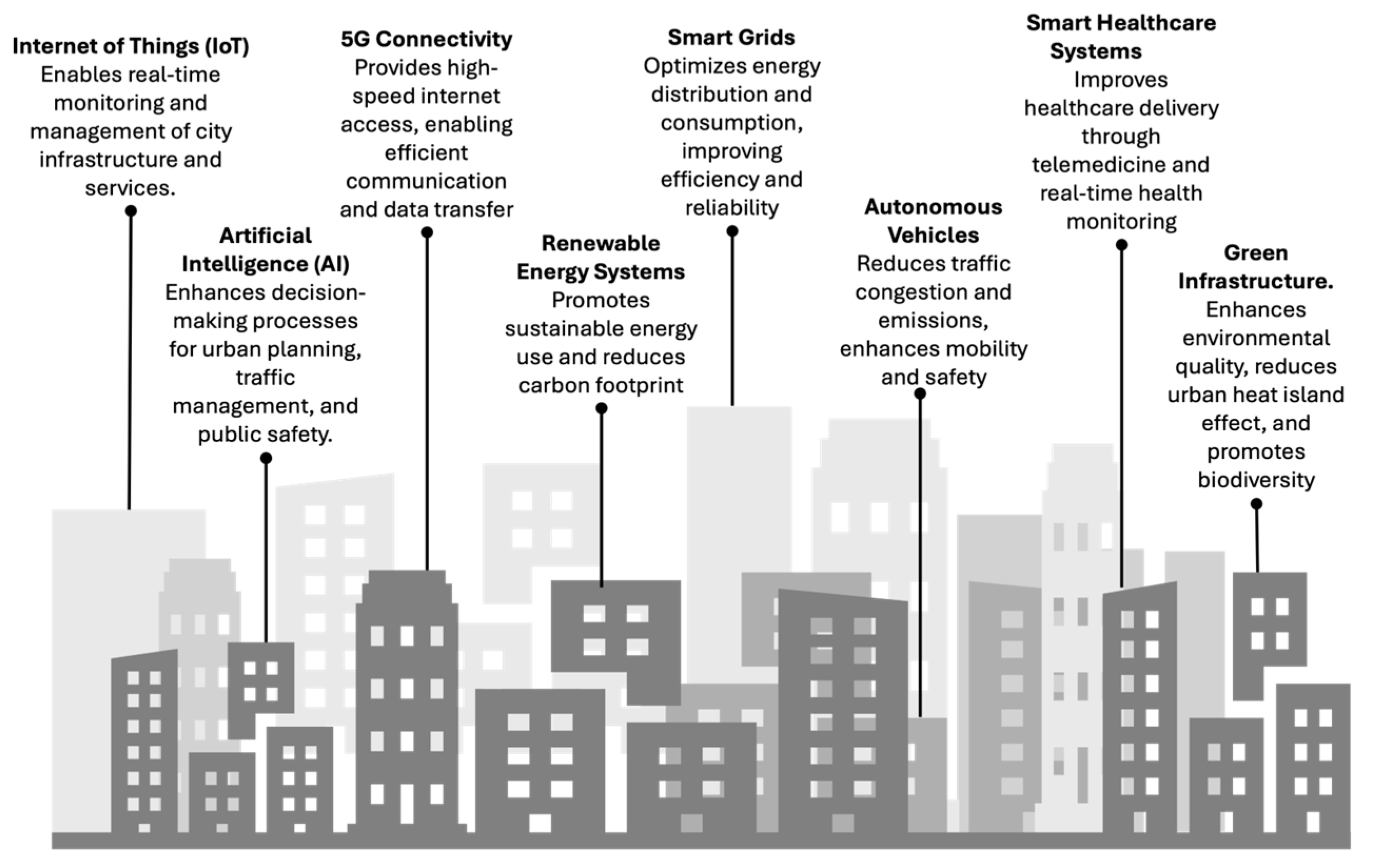


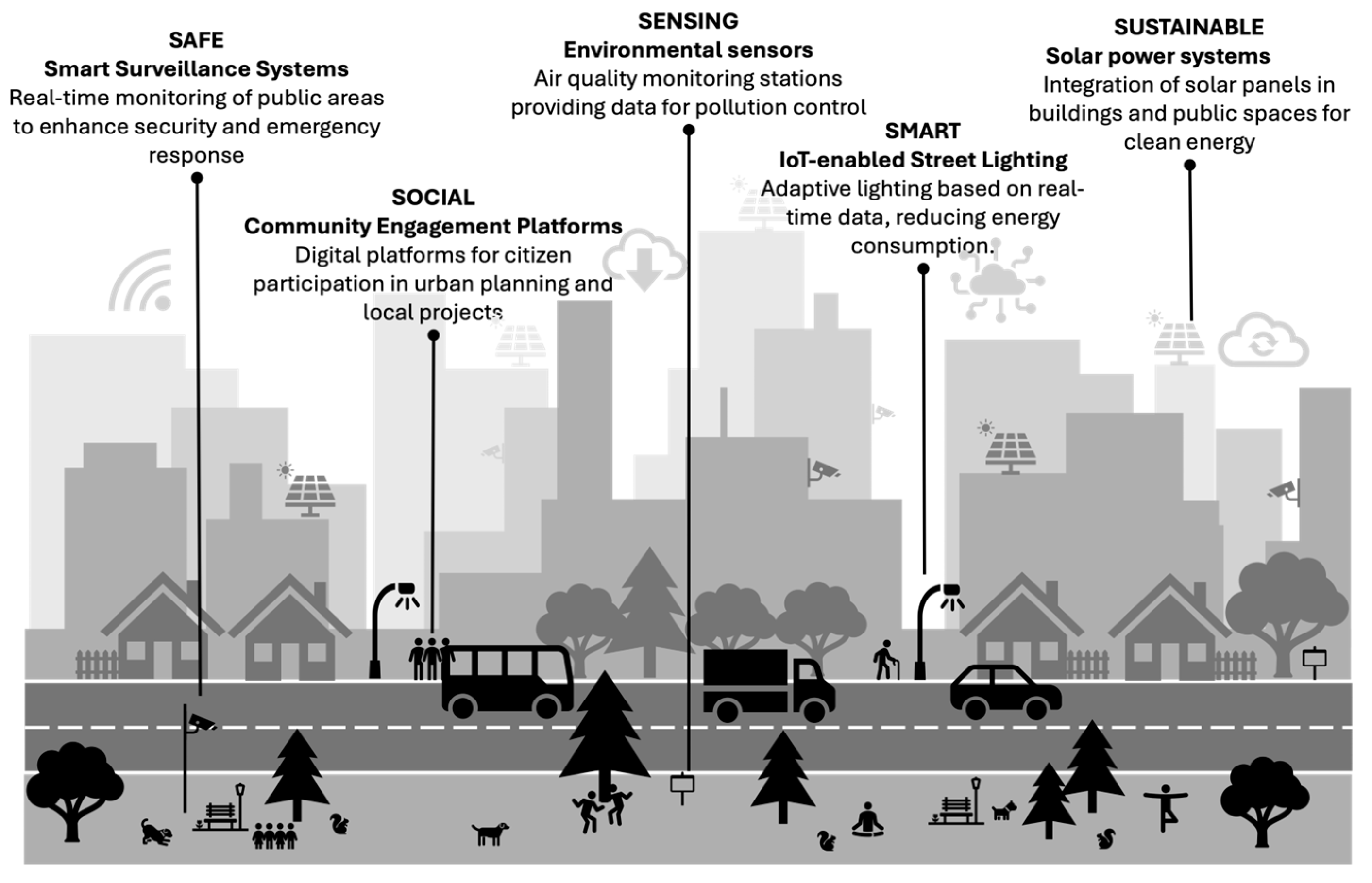

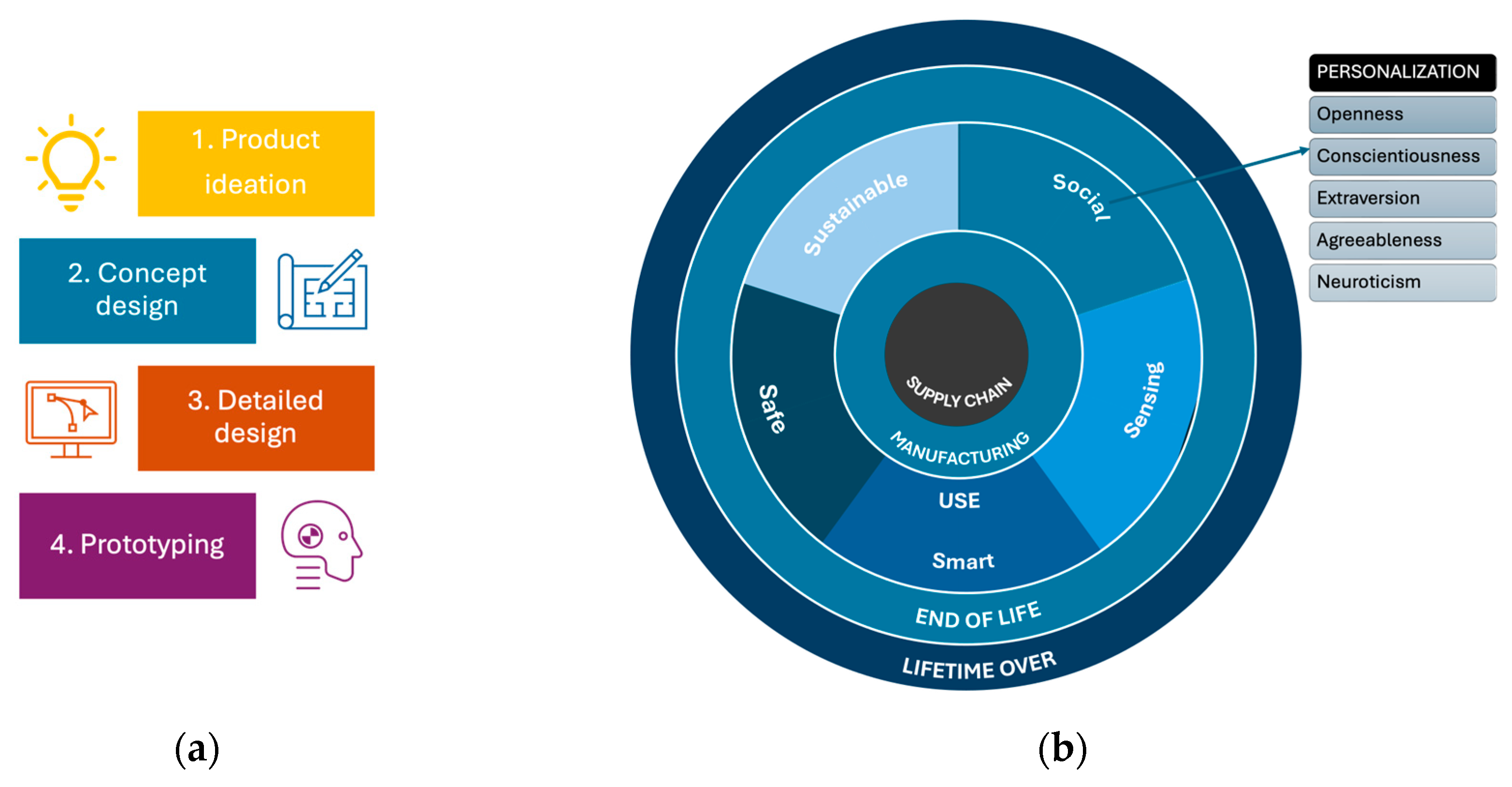
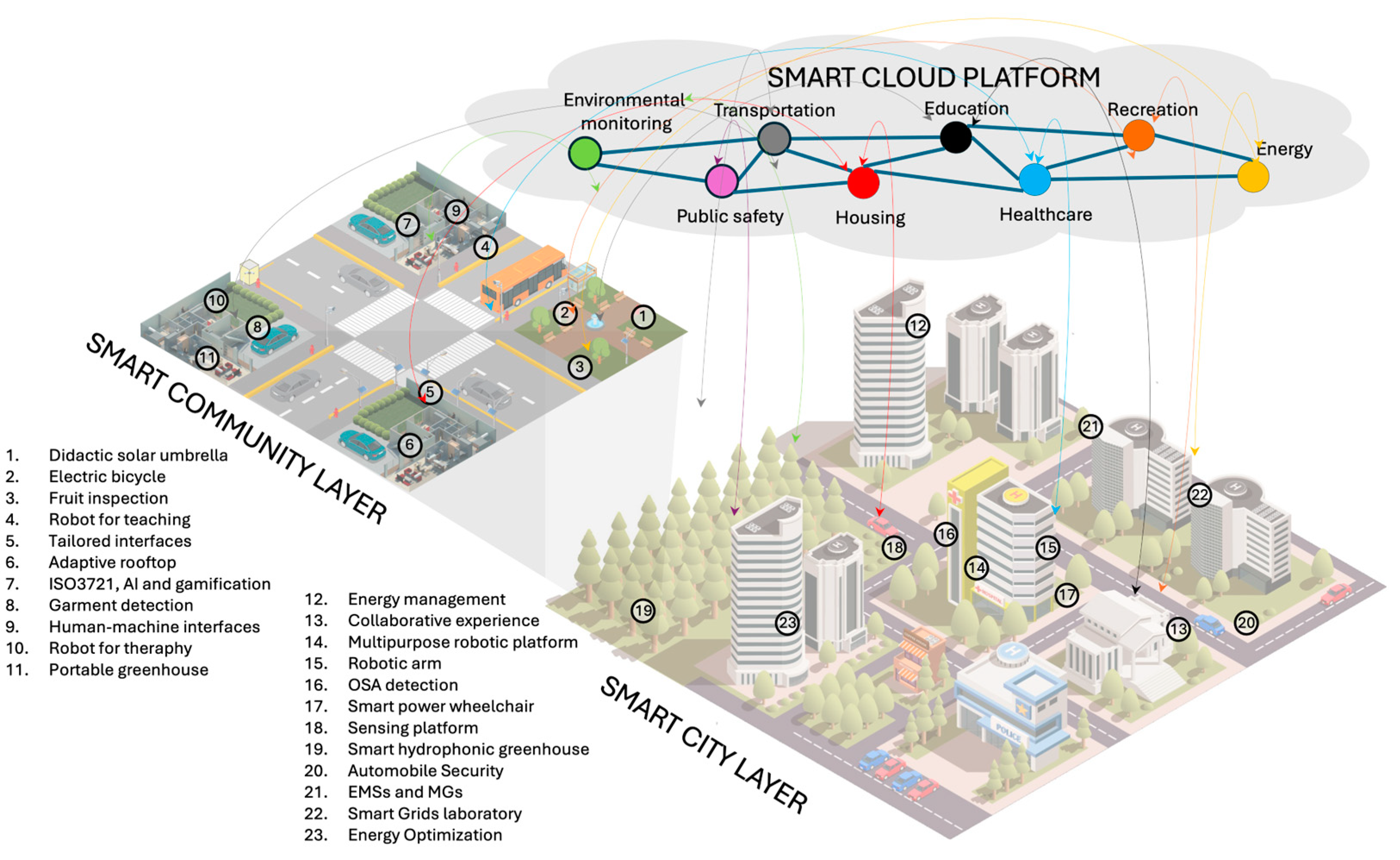

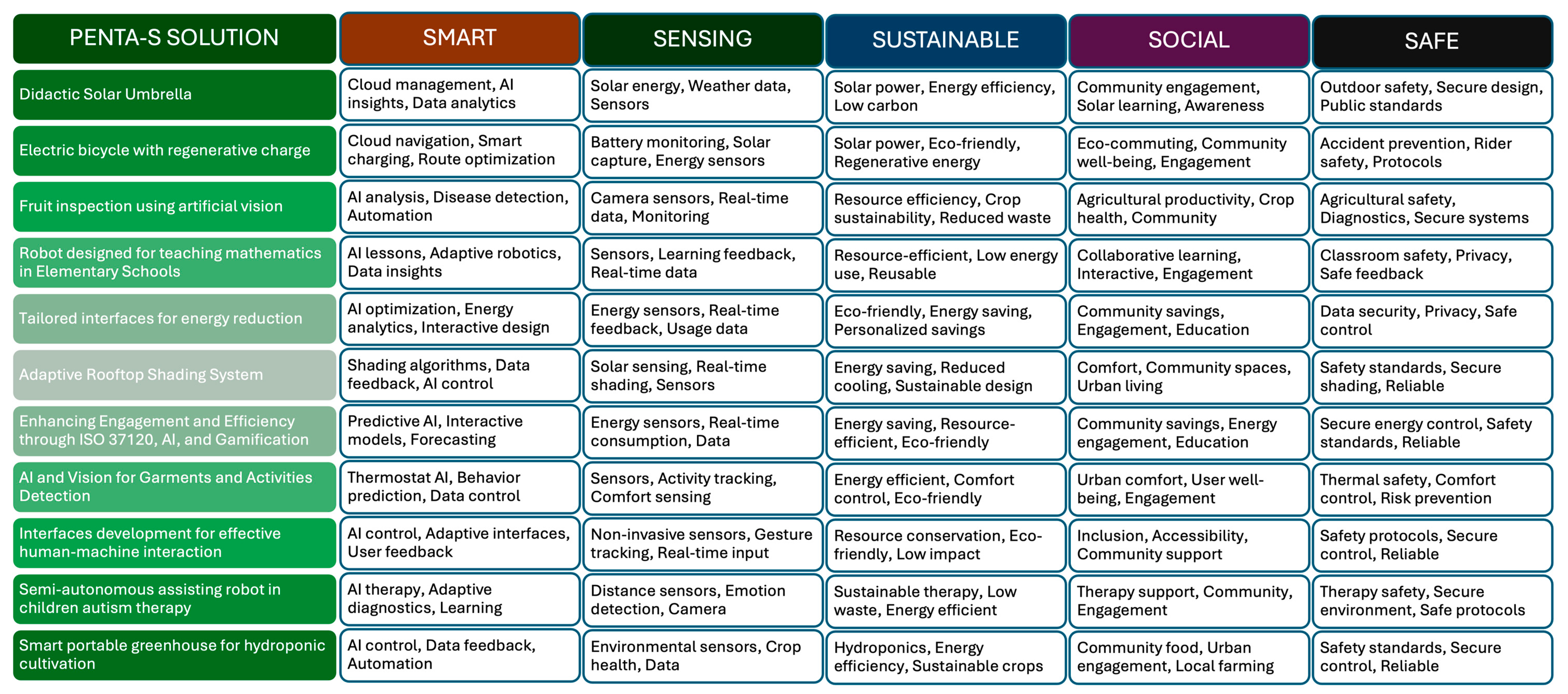
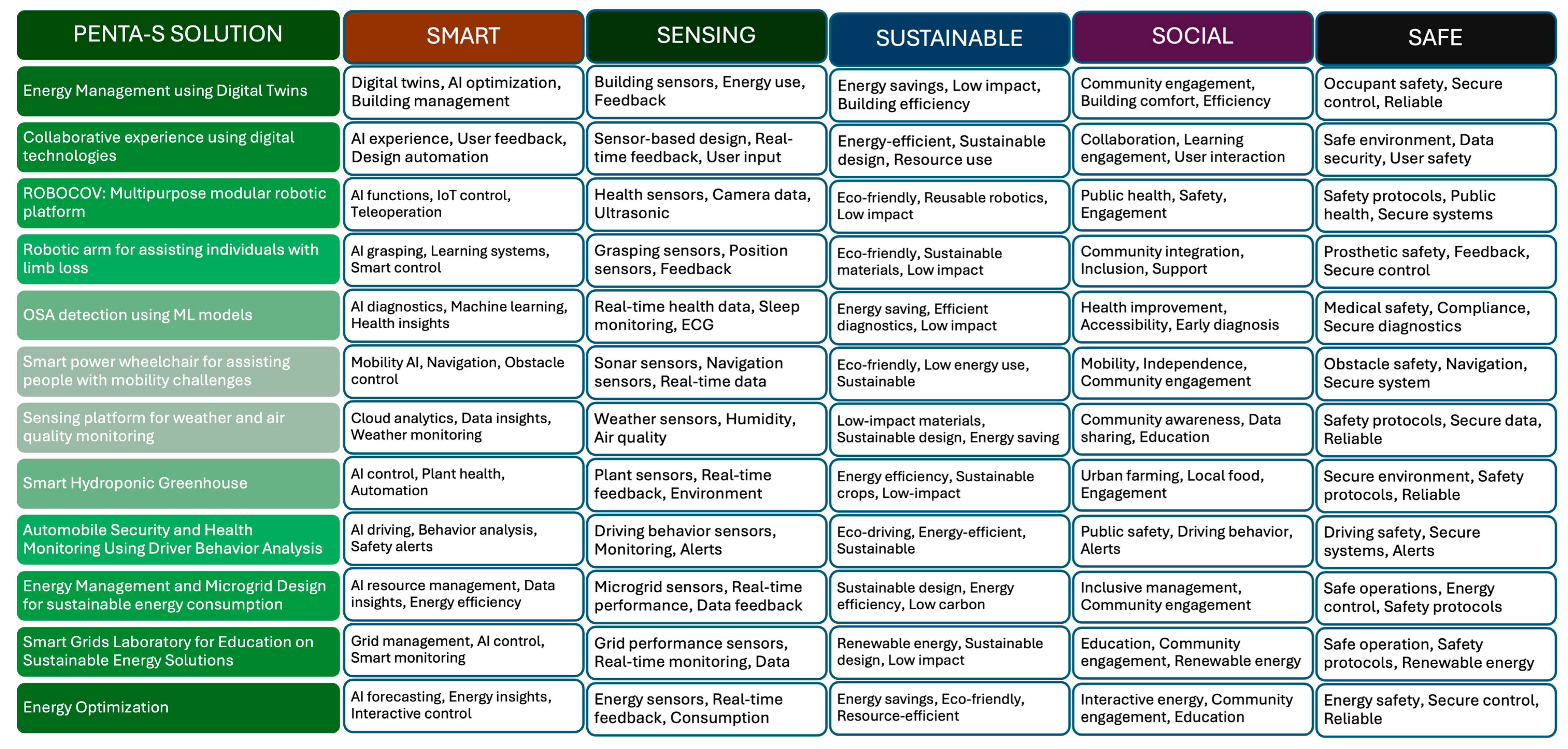

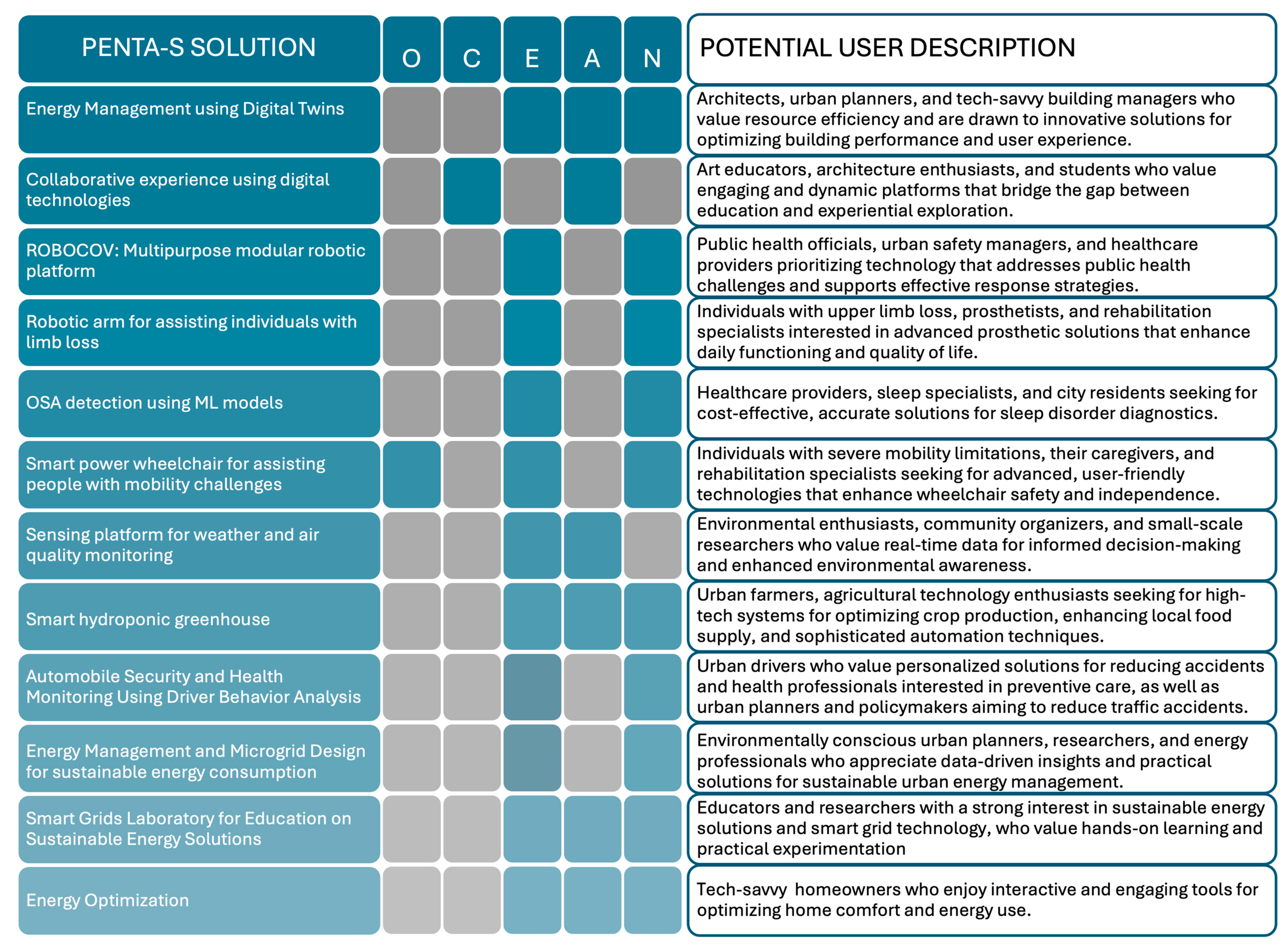
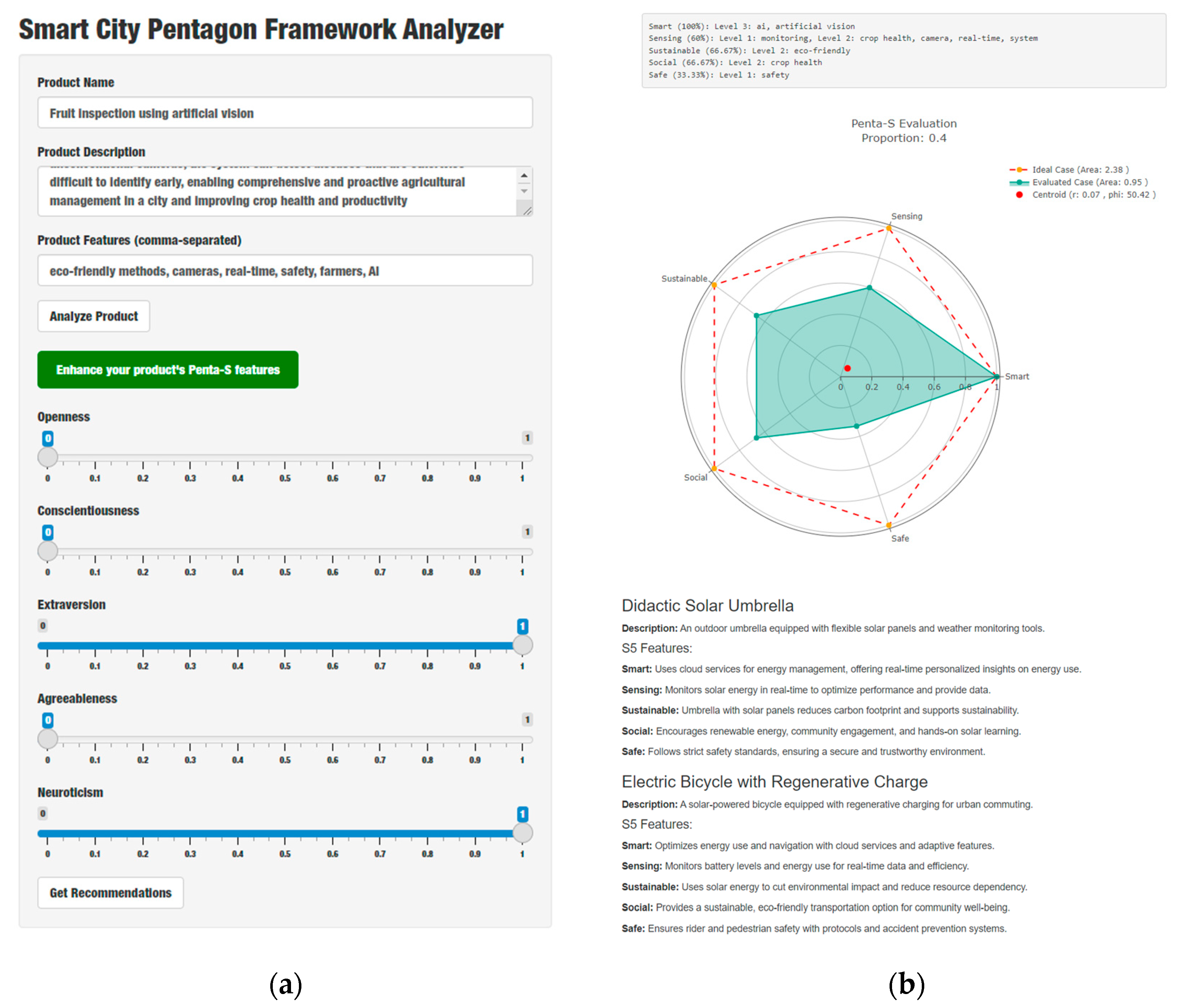

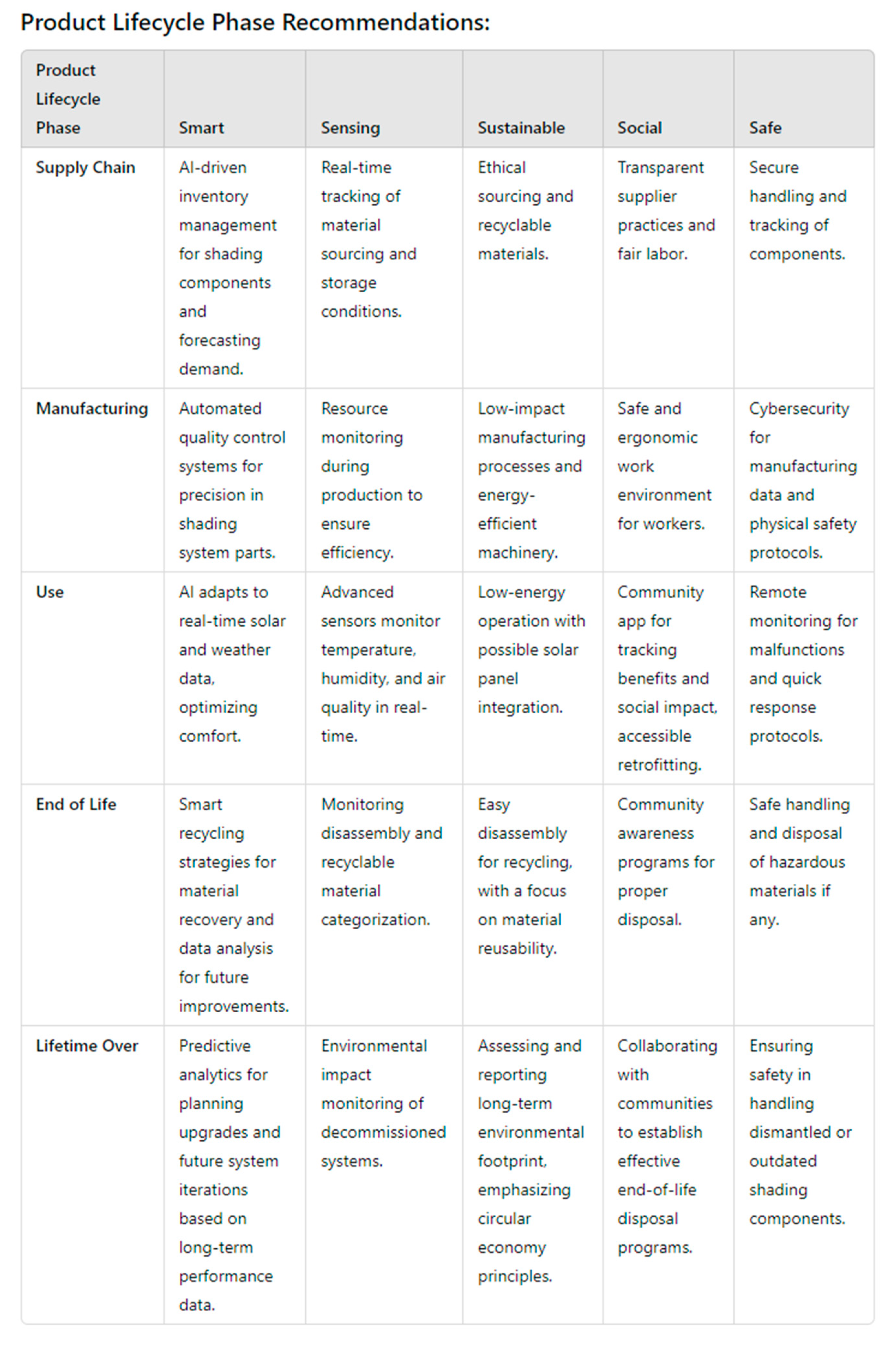
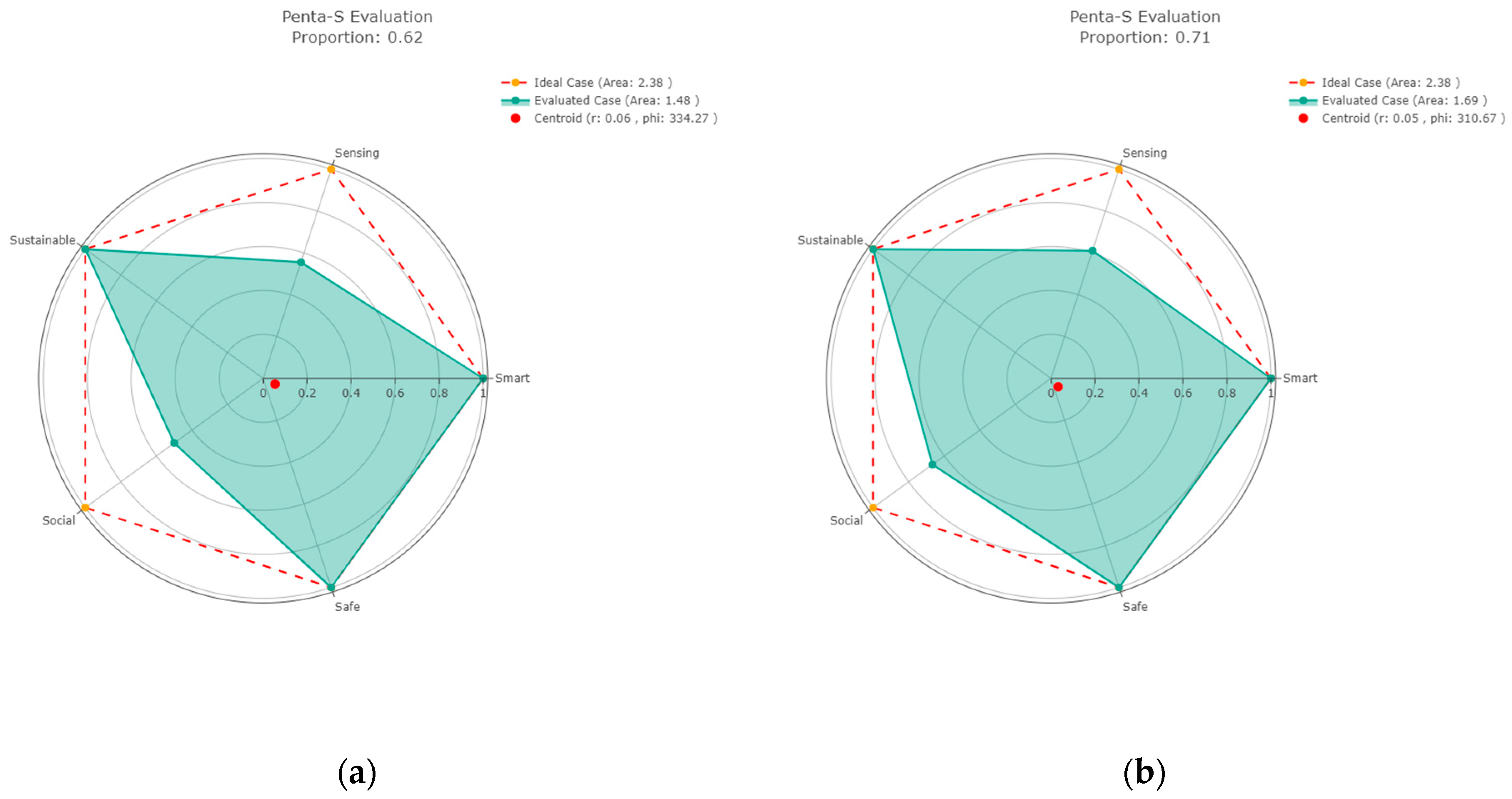
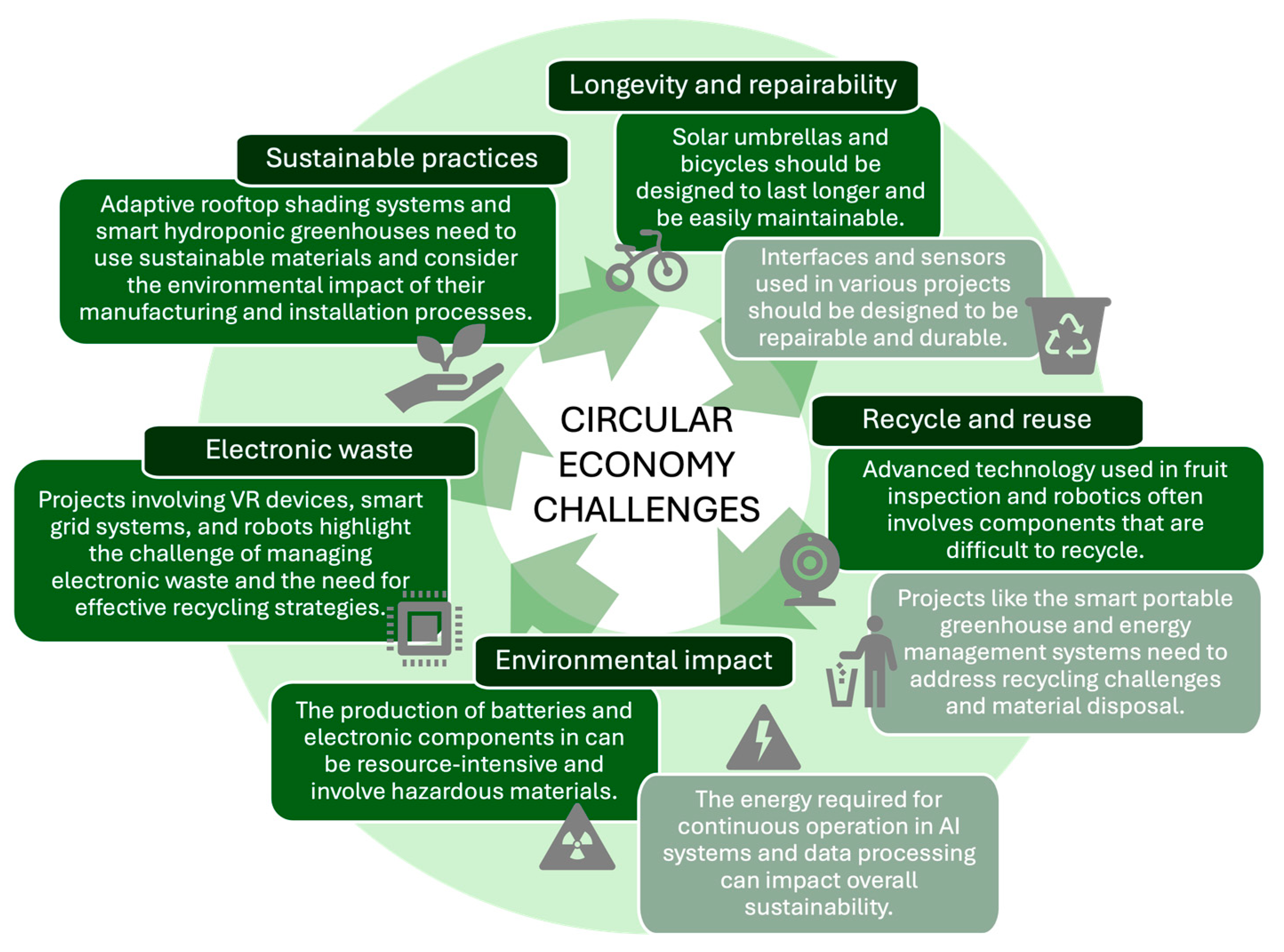

| Phases | Sustainable | Social | Smart | Sensing | Safe |
|---|---|---|---|---|---|
| Supply Chain | Source sustainable raw materials | Promote fair labor practices | Implement smart logistics for tracking | Use sensors to monitor the supply chain | Ensure secure data transmission |
| Optimize transportation to reduce emissions | Ensure transparency in source | Optimize inventory management with AI | Track the environmental impact of the supply chain | Implement security measures to prevent theft | |
| Minimize packaging waste | Support local suppliers | Use blockchain for supply chain transparency | Monitor storage conditions | Ensure safe handling and storage of materials | |
| Manufacturing | Use low-impact, recyclable materials | Ensure high social impact through inclusive design | Integrate smart manufacturing processes | Use sensors for real-time monitoring of production | Implement robust cybersecurity in manufacturing |
| Implement energy-efficient processes | Promote local employment opportunities | Automate quality control | Implement IoT for process optimization | Ensure worker safety and ergonomics | |
| Design for minimal environmental footprint | Consider worker safety and ergonomics | Utilize advanced analytics for efficiency | Monitor resource usage and waste | Secure data handling in manufacturing | |
| Use | Ensure low energy consumption and reduce CO2 emissions | Design for user accessibility and inclusivity in UX | IoT functionalities. Remote monitoring and control | Collect real-time data and user data for improvement | Ensure data privacy, security, and compliance. |
| Promote renewable energy | Ensure health and safety in product use | AI for predictive maintenance | Monitor product performance | Implement safety protocols in product design | |
| Efficient waste management | Foster community engagement | Provide smart UI | Track environmental impact | Safety protocols for design | |
| End of life | Design for easy disassembly and recycling | Ease safe disposal and recycling | Integrate smart recycling technologies | Monitor the disassembly process for safety | Ensure safe disposal methods |
| Use materials that are easy to recycle | Ensure community awareness about disposal methods | Employ AI to optimize recycling processes | Use sensors to detect recyclable materials | Implement safe handling of hazardous materials | |
| Minimize waste generation | Support social initiatives for recycling and reuse | Implement smart waste management systems | Monitor waste streams for efficiency | Ensure safety in end-of-life processing | |
| Lifetime over | Low-impact, recyclable materials | Promote community recycling | AI to predict and manage waste streams | Monitor the environmental impact of waste | Safe disposal to prevent environmental pollution |
| Energy-efficient processes | Disposal methods education | Smart disposal solutions | Track hazardous material disposal | Hazardous materials safe handling | |
| Minimal environmental footprint design | Collaborate with local governments for waste management | Implement smart waste collection systems | Monitor landfills and recycling centers | Prevent illegal dumping and manage e-waste safely |
| Product Penta-S Evaluation | Penta-S Level |
|---|---|
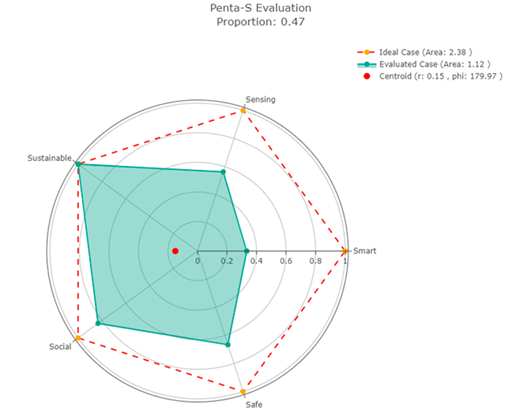 Didactic solar umbrella | Smart (33.33%): Level 1: weather monitoring, automated reports Sensing (56.41%): Level 1: sensors, monitoring, data, energy sensor. Level 2: solar energy, energy sensors, real-time data, environment, real time, environmental, system, information, energy management Sustainable (100%): Level 3: solar energy Social (83.33%): Level 2: public space. Level 3: education Safe (66.67%): Level 2: public space |
 Electric bicycle | Smart (100%): Level 3: AI Sensing (60%): Level 1: flow. Level 2: solar energy, real time, capture, system Sustainable (91.67%): Level 2: eco-friendly. Level 3: solar energy, renewable energy, sustainable Social (66.67%): Level 2: community Safe (66.67%): Level 2: renewable energy |
 Fruit inspection | Smart (100%): Level 3: AI, artificial vision Sensing (60%): Level 1: monitoring. Level 2: crop health, camera, real time, system Sustainable (66.67%): Level 2: eco-friendly Social (66.67%): Level 2: crop health Safe (33.33%): Level 1: safety |
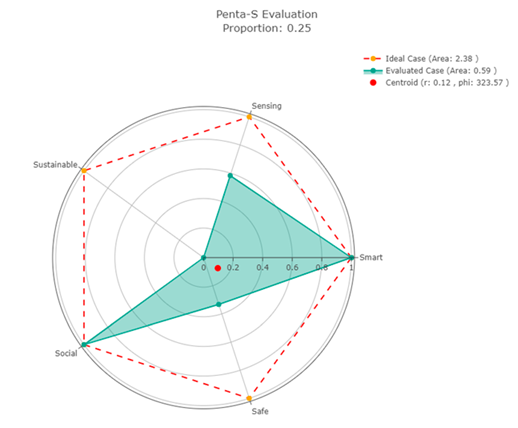 Robot for teaching | Smart (100%): Level 3: AI Sensing (58.33%): Level 1: feedback. Level 2: environment, real time, system Sustainable (0%): No relevant keywords found Social (100%): Level 3: education Safe (33.33%): Level 1: feedback |
 Tailored interfaces | Smart (80%): Level 1: cloud services. Level 2: energy control. Level 3: AI analysis, AI, tailored Sensing (60%): Level 1: data, temperature. Level 2: real-time data, environment, real time, environmental, system, analysis, control, energy management Sustainable (100%): Level 3: sustainable Social (93.33%): Level 2: community. Level 3: tailored, personalized, gamified, gamification Safe (83.33%): Level 2: risk management. Level 3: energy control |
 Adaptive Rooftop Shading | Smart (100%): Level 3: AI Sensing (55.56%): Level 1: data, light. Level 2: environment, consumption, environmental, system Sustainable (100%): Level 3: energy saving, sustainable Social (50%): Level 1: comfort. Level 2: community Safe (100%): Level 3: city infrastructure |
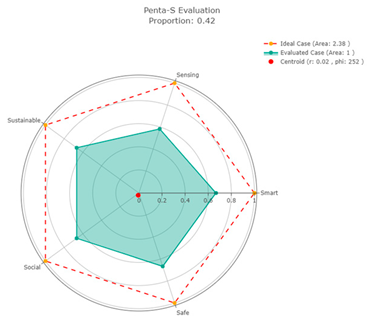 ISO3721, AI, and gamification | Smart (66.67%): Level 1: energy monitoring. Level 2: energy efficiency. Level 3: AI Sensing (58.33%): Level 1: monitoring, data. Level 2: energy use, environment, real time, environmental, system, energy management Sustainable (66.67%): Level 2: eco-friendly, energy efficiency, pet Social (66.67%): Level 1: awareness. Level 2: engagement, community. Level 3: gamified Safe (66.67%): Level 2: energy efficiency |
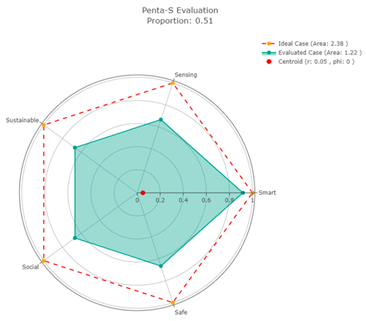 Garment detection | Smart (91.67%): Level 2: energy efficiency. Level 3: AI, computer vision, tailored Sensing (66.67%): Level 2: energy use, camera, consumption, system Sustainable (66.67%): Level 2: energy efficiency Social (66.67%): Level 1: comfort. Level 3: tailored Safe (66.67%): Level 2: risk management, energy efficiency |
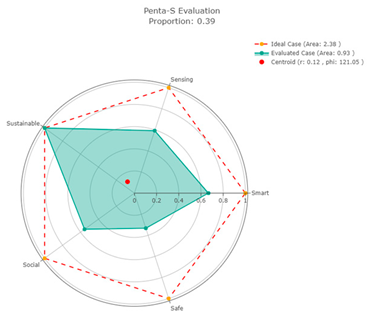 Human–machine interfaces | Smart (100%): Level 3: AI Sensing (59.26%): Level 1: monitoring, data. Level 2: environment, camera, real time, tracking, capture, system, control Sustainable (100%): Level 3: glass Social (55.56%): Level 1: independence. Level 2: mobility, accessibility Safe (33.33%): Level 1: safety |
Disclaimer/Publisher’s Note: The statements, opinions and data contained in all publications are solely those of the individual author(s) and contributor(s) and not of MDPI and/or the editor(s). MDPI and/or the editor(s) disclaim responsibility for any injury to people or property resulting from any ideas, methods, instructions or products referred to in the content. |
© 2024 by the authors. Licensee MDPI, Basel, Switzerland. This article is an open access article distributed under the terms and conditions of the Creative Commons Attribution (CC BY) license (https://creativecommons.org/licenses/by/4.0/).
Share and Cite
Ponce, P.; Rojas, M.; Mendez, J.I.; Anthony, B.; Bradley, R.; Fayek, A.R. Smart City Products and Their Materials Assessment Using the Pentagon Framework. Multimodal Technol. Interact. 2025, 9, 1. https://doi.org/10.3390/mti9010001
Ponce P, Rojas M, Mendez JI, Anthony B, Bradley R, Fayek AR. Smart City Products and Their Materials Assessment Using the Pentagon Framework. Multimodal Technologies and Interaction. 2025; 9(1):1. https://doi.org/10.3390/mti9010001
Chicago/Turabian StylePonce, Pedro, Mario Rojas, Juana Isabel Mendez, Brian Anthony, Russel Bradley, and Aminah Robinson Fayek. 2025. "Smart City Products and Their Materials Assessment Using the Pentagon Framework" Multimodal Technologies and Interaction 9, no. 1: 1. https://doi.org/10.3390/mti9010001
APA StylePonce, P., Rojas, M., Mendez, J. I., Anthony, B., Bradley, R., & Fayek, A. R. (2025). Smart City Products and Their Materials Assessment Using the Pentagon Framework. Multimodal Technologies and Interaction, 9(1), 1. https://doi.org/10.3390/mti9010001








